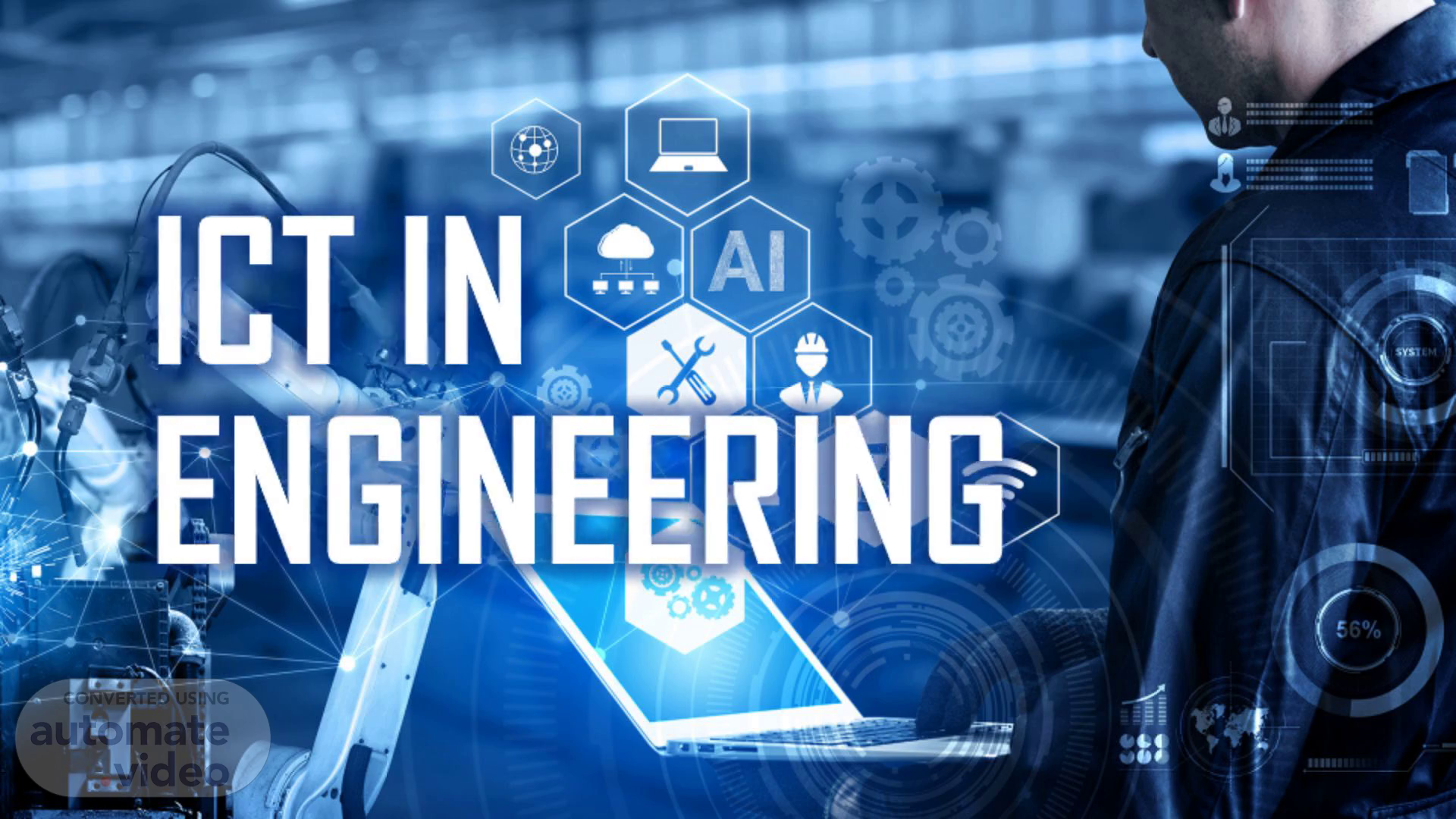Page 1 (0s)
ICT IN ENGINEERING. [image]. [image] YOG. [image] YOG.
Page 2 (7s)
GROUP MEMBERS. N.F.F NAFHA B.M. SEHENSA M. ABEYRATNE VIDUSHI .S .R. JAYASURIYA DEVANGA C. GUNASEKARA.
Page 3 (19s)
Artificial Intelligence (AI). Table of contents. 01.
Page 4 (43s)
Introduction to ICT in Engineering. 01.
Page 5 (54s)
Introduction to ICT in Engineering. Overview of IT in Engineering : IT plays a important role in modern engineering, enabling the automation, digital communication and digital processing across various field. Importance of IT in Engineering : ICT improves engineering effectiveness, timeliness , and invention by taking advantage of modern technologies such as CAD, simulation tools, and automation systems. Integrations with Engineering Processes : ICT is used in engineering for design, analysis, data management, and communication , transforming the way projects are imagined, generated and implemented..
Page 6 (1m 19s)
Digital Design Tools. 02.
Page 7 (1m 27s)
Digital Design Tools. The term "digital design" describes the use of computer-aided design (CAD) software to create virtual representations of objects, buildings, or systems. Before real prototypes are constructed, these models are used to visualize, simulate, and iterate on designs during the design process..
Page 8 (2m 7s)
Big Data in Engineering. 03.
Page 9 (2m 15s)
Big Data Analytics. Engineering Data Analysis: Uses big data analytics technologies for data extraction. Handles massive datasets for optimization, performance evaluation , and predictive maintenance..
Page 10 (2m 28s)
Internet of Things ( IoT ) in Engineering. 04.
Page 11 (2m 38s)
Internet of Things(IoT) in Engineering. IoT technologies are transforming engineering systems by linking devices to the internet, allowing for real-time monitoring, control, and optimization, which increases efficiency and enables proactive maintenance strategies..
Page 12 (2m 52s)
Digital Twin Technology. 05.
Page 13 (2m 59s)
Digital Twin Technology. Engineering's digital twin technology generates a real-time digital model of a physical asset, system, or process, displaying its behavior and performance throughout its life cycle. This model uses real-time data from sensors to monitor and optimize performance..
Page 14 (3m 15s)
Cloud Computing. 06.
Page 15 (3m 22s)
Cloud Computing. Scalable Storage Solutions : Cloud computing provides scalable and adaptable storage solutions, enabling engineering firms to efficiently store, manage, and access huge amounts of project data and assets. High-Performance Computing : Cloud systems offer significant computing capacity for engineering operations like simulation, analysis, and graphics, making complex calculations and processing easier. Collaboration tools : Cloud-based collaboration solutions facilitate distributed engineering, allowing for real-time communication , document sharing, and version control in design and development projects..
Page 16 (3m 48s)
Robotics and Automation. 07.
Page 17 (3m 58s)
Robotics and Automation. ICT plays an important role in the development and control of robots and automated systems in engineering, improving efficiency, precision, and safety in manufacturing and other industries. These technologies transform processes, boost productivity, and offer new capabilities across a variety of industries..
Page 18 (4m 15s)
Virtual Reality(VR) and Automated Reality(AR) in Engineering.
Page 19 (4m 23s)
Virtual Reality(VR) and Automated Reality(AR) in Engineering.
Page 20 (4m 49s)
Mobile Applications. 09.
Page 21 (4m 59s)
Mobile Applications. What is a Mobile App? Mobile app refers to a software application developed for smartphones and tablets that offers various functions and services to users..
Page 22 (5m 17s)
Artificial Intelligence(AI). 10.
Page 23 (5m 24s)
Artificial Intelligence (AI). AI Applications in Engineering : AI applications in engineering include predictive analytics, autonomous systems, intelligent automation, and artificial neural networks to improve operational efficiency and decision-making. Automated Processes and Functions : Machine learning algorithms automate complicated engineering operations, data processing, and decision-making, resulting in higher productivity, lower errors, and better resource utilization. Pattern Recognition and Decision Support: AI and machine learning analyze complicated engineering data to find patterns, anomalies, and opportunities for optimization, enabling advanced pattern recognition and decision assistance..
Page 24 (5m 51s)
Remote Monitoring and Control. 11.
Page 25 (5m 59s)
Remote Monitoring and Control. Remote monitoring and control in engineering enables engineers to monitor and manage equipment, machinery, and processes remotely via communication technology. This enables proactive maintenance, early anomaly identification, and operational optimization, resulting in increased efficiency, reduced idle time, and greater safety. Secure communication protocols maintain information security and prevent unauthorized access..
Page 26 (6m 19s)
Cybersecurity. 12.
Page 27 (6m 27s)
Cybersecurity. Cyber Threats : Cyber threats to engineering industries include hacking, unauthorized access, and malware attacks, which may harm sensitive information and affect operations. Secure Communication Systems: Establishing secure communication protocols and protection actions is critical for safeguarding sensitive engineering data and ensuring information sharing. Data Protection: Maintaining strong data protection actions and identification is important for protecting engineering work and sensitive information..
Page 28 (6m 47s)
Conclusion and Future Perspective. 13.
Page 29 (6m 56s)
Conclusion and Future Perspective. Emerging Technologies and Industry 4.0: AI, IoT , blockchain , and Industry 4.0 principles are driving the future of IT in engineering by improving and optimizing engineering processes, production systems, and digital innovation. Automation Trends and Smart Manufacturing: The merger of IT and engineering has resulted in widespread automation trends and the growth of smart manufacturing, which allows for networked systems, automated operations, and real-time data analytics for flexible decision-making. Skills and Talent Development: The changing landscape of IT in engineering demand increased skill and talent development in areas such as cybersecurity, data analytics, AI, IoT , and digital design, resulting in a workforce prepared to face the challenges of digital transformation and technological advancement..
Page 30 (7m 32s)
Conclusion. ICT has transformed engineering methods by delivering tools and solutions that promote efficiency, innovation, and collaboration. Modern developments in artificial intelligence, big data analytics, and remote communication technologies enable engineers to solve complicated problems, optimize operations, and improve advancement in engineering fields..
Page 31 (7m 49s)
THANKYOU!!.
